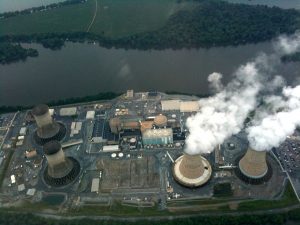 If climate change is considered a real concern by most government officials, why are policymakers and politicians not acting to keep reliably operational nuclear plants from being prematurely shutdown? As most know, nuclear-generating plants, such as Three-mile Island in Pennsylvania, produce essentially zero carbon dioxide and other climate-altering gases. Once the United States had 104 operating nuclear plants producing over 60% of the nation’s clean energy. Today that number is down to 99. Nuclear plants used to generate about 20% of the electricity consumed. Today it is about 17% and declining.
If climate change is considered a real concern by most government officials, why are policymakers and politicians not acting to keep reliably operational nuclear plants from being prematurely shutdown? As most know, nuclear-generating plants, such as Three-mile Island in Pennsylvania, produce essentially zero carbon dioxide and other climate-altering gases. Once the United States had 104 operating nuclear plants producing over 60% of the nation’s clean energy. Today that number is down to 99. Nuclear plants used to generate about 20% of the electricity consumed. Today it is about 17% and declining.
The most recently announced shutdown was the Three Mile Island Unit 1 due to competition from cheap fracked natural gas and heavily subsidized wind and solar. To make matters worse, several states have issued renewable energy mandates requiring minimum levels of production from these plants regardless of cost. Some states, largely under the pressure of loss of jobs and impact on the local economy, not climate change, have enacted some temporary financial measures to keep nuclear plants in New York and Illinois open. Several more merchant nuclear plants are vulnerable in other states. In total, 1,718 Mwe of clean nuclear power has been prematurely shut down with announcements to close another 1,436 Mwe. Most of this baseload power (operating whether the wind blows or sun shines) is being replaced by natural gas, adding another 25 million tons of CO2 into the air annually. This is certainly not the optimal way to address climate change.
What is the solution? Why not give clean air credits similar to those given to solar and wind to nuclear energy plants, leveling the energy playing field and ending costly mandates that raise the price of electricity for consumers.
In the peer-reviewed article at http://www.ndt.net/article/v04n05/oldberg/oldberg.htm a colleague and I expose a safety hazard of nuclear power that has been ignored by the government over more than three decades. The… Read more »
Terry, I just briefly looked at your statistical analysis of NDE. In nuclear plants these days, there is full inspection of suspect steam generator tubes and if defects are discovered… Read more »
Andrew: Thank you for taking the time to reply. The safety hazard that I have in mind lies in a fallacious argument that is made by our federal government. Under this… Read more »
Because I believe that climate change represents a huge threat to our planet, I support actions that would abate this threat. This includes supporting nuclear power, but also supporting renewable… Read more »
While nuclear power is mostly carbon-free and, therefore, an appropriate way to move away from fossil fuels, it has a number of drawbacks that make it ill-suited for fighting climate… Read more »
Dan needs to compare the price of electricity in Denmark to that of France which is largely served by nuclear power to add some realism to his comment. Further, Denmark… Read more »
Dan, I think you missed my point. I was discussing how to keep existing nuclear plants from prematurely shutting down not necessarily building new ones. As stated, by shutting them… Read more »
Herschel/Andrew: I’m sorry for providing a confusing message. I’m anti-CO2, not anti-nuclear. I do think that existing nuclear plants should stay open while we shut down fossil fuel plants. But… Read more »
Dan, I guess then the argument comes down to economics. Existing plants can not compete with cheap fracked gas or heavily subsidized solar and wind and government policies that require… Read more »
I agree that this is based on economics. Climate change exists because we allow fossil fuel companies to pollute the atmosphere for free. If we correct that market failure, it… Read more »
Dan, I believe that there are some serious defects in the arguments you present. In previous comments you have argued about the existential threat of climate change: the destruction it could… Read more »
Herschel: As I mentioned, I’m not ideologically opposed to nuclear energy. I do think it has problems though: Nuclear is expensive: Existing plants are being shut down because they are… Read more »
I would like to add to Herschel’s well researched response to Dan’s July 4th comment regarding nuclear’s alleged problems as he calls them. They are: Nuclear is expensive: Existing plants are… Read more »
Andrew: Thank you for your comments on my post. Some quick replies: Re: Nuclear is expensive: The levelized cost of nuclear, according to the EIA is $108.4/MWh. For wind it’s… Read more »
Miller’s cost arguments should take into account the added costs in the U.S. of emotional opposition to nuclear power and regulatory burdens that can escalate to the point of being counterproductive… Read more »
Dr. Kadak, I agree that it does not make sense to shut down existing nuclear power plants prematurely because of their insignificant greenhouse gas emissions. Presumably new natural gas power… Read more »
Henry, As you may be aware, or surprised, that over 40 of the existing (you call them obsolete) nuclear plants that are operating beyond their 40 year initial licensed life.… Read more »
What make you think it is possible for us to “combat” climate change?